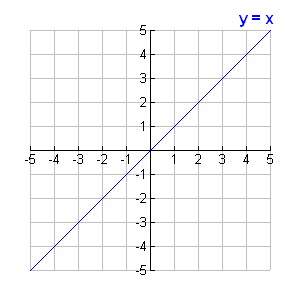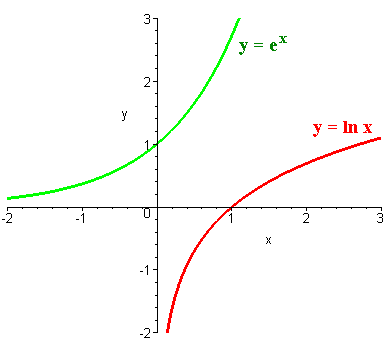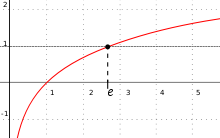Function of y = x
Or
" demystifying y = ln x ".
y
= x
y
= ex
and
y = ln x
y
= ln x is a mirror (reflected) image of y = ex
about y = x. Or you fold this chart (paper) along the line of y = x
the red line is exactly on the green line. This is in 3D 180 degree
rotation as y = x an axis. Or an ant starts waking from at any point
of the red line to go toward the green line and takes the shorted
distance to reach a point of the green line (by crossing the line of
y = x at 90 degree angle or mathematically walk on the normal line
). This is <inverse>relation.
This may have a profound meaning. You can easily check this by using
for instance
y = x +5 (or y = x + a, for more general)
y
= x 2
It helps you to get an idea of ln x =
y.
ln x = y
is, by definition
ey
= x, which is the exchange of x and y in ex=
y( y = ex).
As a
reminder
The mirror or reflected image of Point (x=2, y =5)
about y = x is Point (x=5, y = 2), which is easily found in the
above chart of y = x. The function of y = x is great.
Additional
insight to Function of y = x and e
I was stuck with
following explanation found in <e
(mathematical constant)>Wiki.
”
The graphs of the functions x ↦ ax are shown for a = 2 (dotted), a = e (blue), and a = 4 (dashed). They all pass through the point (0,1), but the red line (which has slope 1) is tangent to only ex there.
The value of the natural log function for argument e, i.e. ln(e), equals 1.
The
principal motivation for introducing the number e,
particularly in calculus,
is to perform differential
and integral
calculus with exponential
functions and logarithms.[16]
A general exponential function y
= ax
has a derivative, given by a limit:
The parenthesized limit on the right is independent of the variable x: it depends only on the base a. When the base is set to e, this limit is equal to 1, and so e is symbolically defined by the equation:
”
Wiki shows some more other ways to prove this
This
part of the wiki explanation has not changed much in last 10 years
so that this is supposed be accepted by public. I read this part
many times this time. The last part
<When
the base is set to e, this limit is equal to 1, and so e
is symbolically defined by the equation>
Of
this part <When
the base is set to e, this limit is equal to 1>
is a
kind of jumping to the conclusion unless you know that or why / how
the this limit becomes 1. In case of general <a>
when
because h ->0
,
ah - 1
0
---------- =
----
h
0
which does not make sense. <symbolically>
means
in a way <damned important>. <defined by the equation>.
Is this just a definition, or truth ?
Another article (I read
this article many times as
well)
https://brilliant.org/wiki/derivatives-of-exponential-functions/
Derivatives of Exponential Functions
shows similar
explanation but sticks to the general exponential and concludes
d
---- ax = ax
ln a
dx
is
symbolical.
d
---- ax
= ax ln a
dx
is
symbolical too and more general since if you replace a with e you
can get
Some
one
(https://rip94550.wordpress.com/2010/01/18/calculus-where-did-e-come-from/
and else) show an insight
"
This limit is
<ln a>.
"
By definition ln e is
simply 1.
But what does this mean ? <ln a> can be
seen as "the derivative factor of the general exponential "
and is a logarithm with the base e (ln).
d
---- ax = ax
ln a
dx
Where did this come from
?
"
https://www.math24.net/derivatives-exponential-functions/
No(w) we consider the exponential function y=ax with arbitrary base a (a>0,a≠1) and find an expression for its derivative.
then
Using the chain rule, we have
(ax)′=(ex ln a)′=ex ln a⋅(x ln a)′=ex ln a⋅ln a=ax⋅ln a.
Thus
"
<chain
rule> is a special case in this. But this special chain rule is
shown in math text books.
But the point I want to make
here is the first line
As a = eln a,
This
is almost a definition and also usually found in math text books. So
it says " As a = e ln a ".
But remember the following I
wrote above.
ey
=
x, which is the exchange of x and y in ex=
y( y
= ex).
This is <reverse relation>.
ex
is
(natural) exponential function while ln
a
is (natural, base e
) is (natural) logarithm function. ln
a=e ln a, ln a
is a power to e
(e
to the power ln a). This is in a way < inverse relation>. So
intuitively e
ln
a
becomes <a>.
Or
if we use verbs
In ex
<e>is
"exponetized" by <x>
while
in ln
a
<a>
is
"logaithmized" or <inversely
exponentized>by
<e>.
Likewise
in
e
ln a
<e>
is
"exponetized" by <ln
a>by
placed at this position. Since <a>is
"logarithmized" with base <e>
by
place after ln or <inversely
exponentized>by
<e>
e
ln
a
becomes <a>
after "logarthmized" "logarthmized""logarithimized
or<inversely
exponentized>
and
then "exponetized" linking with <e>
by<e>.
-----
Wiki
<exponential
function>says
"
Letting
the number of time intervals per year grow without bound leads to
the limit
definition of the exponential function,
(ex
=)
first
given by Leonhard
Euler.
"
but does not show how Euler found
and gave it.
It is closely connected with the following
definition / characteristic (one of the definitions /
characteristics) :
(e
=)
Repeating
(ex
=)
How
to prove this. I found an answer (may be one of the answers) in the
following article on the net.
<e
the EXPONENTIAL - the Magic Number of GROWTH>
(good
article)
https://www.austms.org.au/Modules/Exp/exp.pdf
As
this is a pdf file it is difficult to copy / paste this part here.
The method is a mathematically tricky one.
The exponent
(power) part changes
n
n/x x
(
) ---> ( (
) )
x
( 1 + --- )
n
Please note the following tricky part.
n
n/x
x
( )
---> ( ( ) )
Then
n → ∞ .
n/x
(
)
This part becomes <e>
by
using
(e
=)
then
we can get
(ex
=)
The
above is modified (so no copyright infringement but principally the
same) and may be difficult to get it. Please go to the original
<e
the EXPONENTIAL - the Magic Number of
GROWTH>
https://www.austms.org.au/Modules/Exp/exp.pdf
ACT


No comments:
Post a Comment